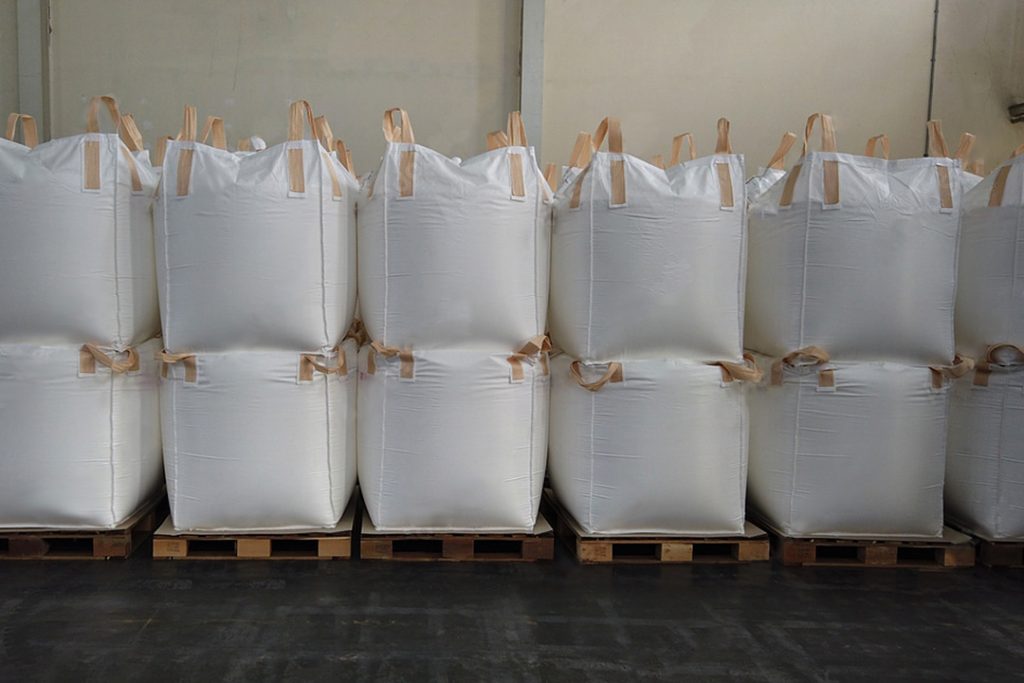Optimising warehouse storage space holds significant benefits for companies. Not only does it improve employee productivity and satisfaction when the warehouse is orderly, but it also improves efficiency and the bottom line. This requires neat packaging that is clearly labelled, documented and easy to find.
Some warehouse managers like to use third-parties to store their inventory to reduce clutter in their warehouses. This is an effective solution, so Custom Bulk Bags offers inventory services to ensure that our customers always have stock of bulk bags when they need it.
We are a leading manufacturer and supplier of high-quality bulk bags in South Africa. We produce up to 3.5 million bulk bags every year – all of which have a minimum safety factor rating of 5:1 and are produced in accordance with international standards and regulations for quality.
Warehouse space is limited
As permanent structures, warehouses have a defined amount of space that often cannot be increased. This means that the space within needs to be optimised for maximum storage and efficiency. Simply buying more warehouse space is not always a viable option, so business leaders need to know how to work with what they have.
Optimising space can increase the usable capacity of a warehouse and yield meaningful results in terms of operating costs and business efficiency. This saves time and money by preventing missed sales or inaccurate stock-take numbers. It helps to keep products organised so that employees know exactly where to find what they’re looking for.

How to optimise warehouse space
There are several ways to optimise the available space:
1. Opt for bulk bags – Packaging is a vital part of storage. Bulk bags are a worthy consideration as they can hold large quantities of material, but can fold up when not in use. Unlike wooden crates, cardboard boxes and metal containers, bulk bags are flexible and can be folded to minimise space when not in use, but they are still stackable and stable.
They are also extremely lightweight but can hold up to two tonnes of material at once. This weight-to-strength ratio surpasses those of cardboard, wood and metal, making bulk bags a cost-effective solution for warehouses. What’s more, they can be customised to suit your every need, including printing on the fabric (barcodes, product information and logos can be printed directly onto the fabric for easier identification and tracking).
2. Redesign the floor plan – The floor plan plays a large role in how much can fit within a warehouse. The width of the aisles between shelves can make it easier to move around and find what you need, but it also affects the storage capacity. Wider aisles mean more room for forklifts, stairs, pallet jacks and employees, but they also mean fewer shelves per square metre.
Aisle width influences the type of equipment you can use, as well as how many employees can fit in the same aisle at the same time. There is a delicate balance between too narrow and too wide – do some research to figure out how to manipulate the floor plan for optimal efficiency and productivity.

3. Choose the right shelves – While aisle width is a critical consideration, so too is the height of shelves. A smaller vertical gap between shelves may allow you to fit more per rack, but it also limits the size of objects and packaging placed on each shelf. You also need to consider what machinery your employees use to move bulk bags and boxes around the warehouse.
By changing your shelving system, you can optimise the space available and minimise wasted space by decreasing the vertical gaps. Measure your packaging to ensure that the shelves are the perfect height, but remember to allow for some clearance space so that you can easily remove and replace bulk bags or boxes.
4. Use a warehouse management system – This is a vital tool for optimising space. A warehouse management system gives you real-time insight into inventory and storage space. You can then free up space by identifying obsolete stock that can be discarded or recycled. Many systems also allow warehouse managers to assign floor space and shelves to products based on their sales volumes and dimensions.
A warehouse management system allows you to manage inventory at every point along the supply chain. When stock is running low, the software will alert you and enable you to place orders before it runs out. This tool improves operation efficiency and allows you to make the most of the available space.
These four factors can help you to optimise your storage space. Bulk bags are a perfect packaging solution for use in warehouses as they are flexible, lightweight, strong and durable. They possess several qualities that warehouse managers need in order to make efficient and effective use of space. For more information about our bulk bags, please contact us today.
___
Custom Bulk Bags is a leading South African manufacturer of woven polypropylene bags for various industries, such as mining, chemicals and food. We are able to produce over 3.5-million bulk bags per year, keeping our customers in stock at all times. Our bags adhere to the highest levels of quality as a result of our stringent in-house testing and quality control programmes.
Custom Bulk Bags holds ISO 9001 certification and we currently have a number of UN-certified designs. We are a Level 2 B-BBEE manufacturer and supplier and fall under the ownership structure of Deneb Investments Limited. For more information on our products, contact sales@custombulkbags.co.za. Follow us on Facebook for our latest news and industry insights.
